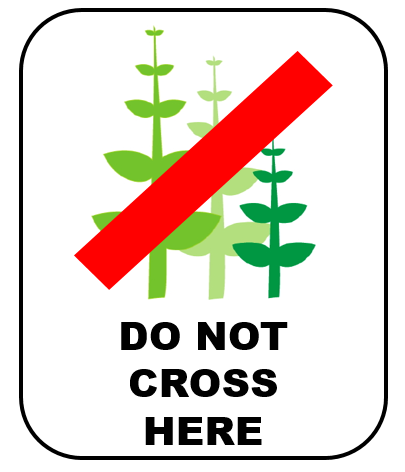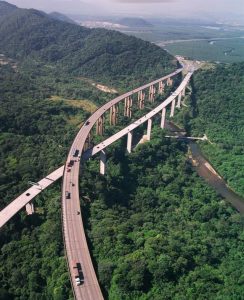Rainforests are considered ‘the finest celebration of nature ever known on the planet’ yet increasing pressure to develop new roads for economic growth is their biggest threat.
Tropical rainforests cover 2-7% of Earth. They support 170,000 plant species. Their small area but tremendous biodiversity makes them global hotspots for conservation funds.
High levels of rainfall and constantly high temperatures creates a unique habitat. Many trees packed closely together creates a closed canopy. As a result, the rainforest is dark and humid. There is lower light, wind and temperatures as a result that species need to be specially adapted to in order to thrive (Laurance et al. 2009).
New developments threaten this structure. Species can either respond and adapt to new conditions or face the risk of extinction.
Rainforests are especially vulnerable to economic pressures. Roughly 2.5 million hectares (25,000km2) of the Brazilian Amazon are lost every year through deforestation. Economic growth is often the main driver for habitat loss. If the current rates continue, within 50 years, global rainforests are likely to be lost forever.
Many activities lead to deforestation but roads are seen as especially detrimental (Figure 1). Opportunities for logging, oil and mining often drive the development of new roads (Goosem 2007). Previously untouched areas are now accessible via roads and are now vulnerable to widespread biodiversity loss (Brudvig et al. 2015; Haddad et al. 2015).

The issue is not only minor access roads but large highways built for an increasingly urban world. The Trans-Amazonian Highway in Brazil is 4000km. This only makes it the third longest highway in Brazil (Figure 2).
Destruction of the rainforest is therefore a primary cause of plant biodiversity loss. Roads will change rainforest habitats from large and pristine to small and isolated. New edges are created alongside roads. Species are impacted more than this than widespread deforestation. This process of habitat fragmentation creates smaller, isolated populations and plant species are lost (Linert 2004; Gossem et al. 2011; Weiner et al. 2014).

Overall, trees lost from the rainforest allows light to reach the ground that was not able to before. Shade preferring species are no longer the best suited. Those plants that thrive on more light become more successful (Laurance et al. 2009). Species that were one dominant no longer are.
These changes to the surrounding environment impact important interacting species. Smaller patches with different conditions attract fewer plant species and therefore fewer pollinators. Pollinating species are likely to decline as a result, threatening their own survival and that of the plants (Aguilar et al. 2006).
If reproductive output declines, the number of species surviving to continue the population declines. The negative cycle continues until a whole species is extinct. Community structure is altered and important interactions are lost.
Each plant species, rare or common, plays an important role in regulating carbon, purifying water and stabilising soil qualities. Loss of species variety creates areas that are extremely similar. Soon, rainforests will lose their functional role and contribute less to the global system.
[496 words]
REFERENCES
Aguilar, R., Ashworth, L., Galetto, L. & Aizen, M. A. (2006) Plant reproductive susceptibility to habitat fragmentation: review and synthesis through a meta-analysis. Ecology Letters, 9, 968-980.
Brudvig, L. A., Damschen, E. I., Haddad, N. M., Levey, D. J. & Tewksbury, J. J. (2015) The influence of habitat fragmentation on multiple plant-animal interactions and plant reproduction. Ecology, 96, 2669-2678.
Cunningham, S. A. (2000) Effects of habitat fragmentation on the reproductive ecology of four plant species in mallee woodland. Conservation Biology, 14, 758-768.
Goosem, M. (2007) Fragmentation impacts caused by roads through rainforests. Current Science, 93, 1587-1595.
Haddad, N. M., Brudvig, L. A., Clobert, J., Davies, K. F., Gonzalez, A., Holt, R. D., Lovejoy, T. E., Sexton, J. O., Austin, M. P., Collins, C. D., Cook, W. M., Damschen, E. I., Ewers, R. M., Foster, B. L., Jenkins, C. N., King, A. J., Laurance, W. F., Levey, D. J., Margules, C. R., Melbourne, B. A., Nicholls, A. O., Orrock, J. L., Song, D. A. & Townshend, J. R. (2015) Habitat fragmentation and its lasting impact on Earth’s ecosystems. Sci. Adv.
Laurance, W. F., Goosem, M. & Laurance, S. G. W. (2009) Impacts of roads and linear clearings on tropical forests. TREE, 1149, 1-11.
Lienert, J. (2004) Habitat fragmentation effects on fitness of plant populations – a review. Journal for Nature Conservation, 12, 53-72.
Weiner, C. N., Werner, M., Linsenmair, K. E. & Bluthgen, N. (2014) Land-use impacts on plant-pollinator networks: interaction strength and specialisation predict pollinator declines. Ecology, 95, 466-474.
Recent Comments